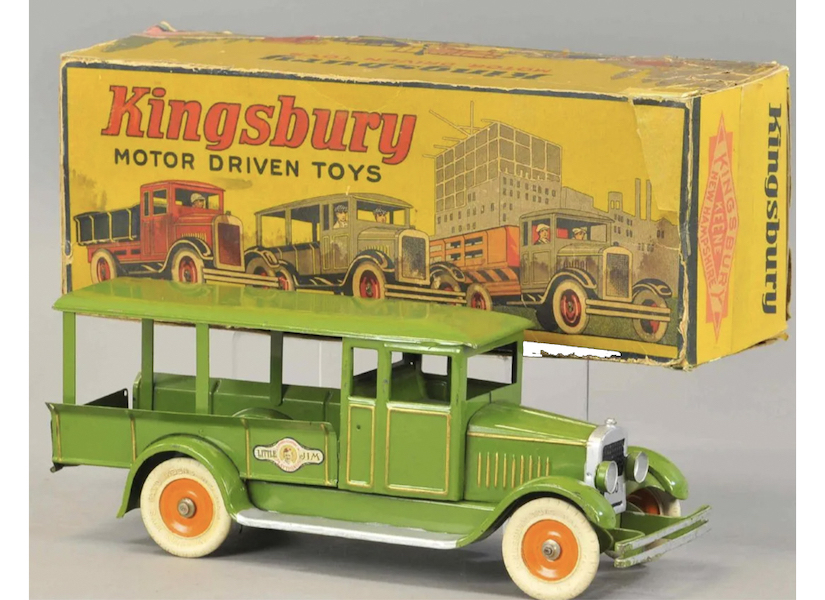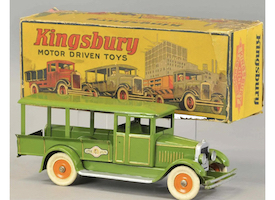
NEW YORK — The story of Kingsbury’s toys is very much the story of manufacturing in small-town America around the turn of the 20th century.
Nestled in the Connecticut River Valley near the Vermont border, the city of Keene, New Hampshire was incorporated in 1874, and by 1890, it had a population of slightly more than 7,400 people. As in many other Northeastern cities, manufacturing was a stronghold. Keene became known for making wooden objects, carriages and saddles, textiles and pottery. Among its enduring legacies are the pressed-steel toys by the Kingsbury toy company, which actually began not with a Kingsbury, but a Wilkins.
In 1890, James S. Wilkins founded the Wilkins Toy Company to make tin and iron toys and novelties and is noted for manufacturing cast iron train sets and fire engines up to about 1919. Wilkins may have had a keen eye for design, but his business acumen was not as developed, and in 1894, he had to sell his business to a local bicycle shop owner, Harry T. Kingsbury and his grandfather. The move saved the company, and working together, Kingsbury and Wilkins expanded the product line to other cast-iron toys such as cook stoves, circus toys, farm machines, carriages, trolleys, banks, airplanes and ships. Producing his first toy catalog a year after assuming control of the company, Kingsbury featured 85 iron toys, complete with illustrations.

“The company made toys for boys and girls, producing some of the first toy automobiles with lady drivers … using clockworks-style technology in his vehicles, Kingsbury’s trains and fire trucks and other vehicles could be wound up and let go to drive across the room,” according to the Historical Society of Cheshire County in Keene, which has a collection of 250 of the company’s toys.
A born tinkerer with mechanical know-how, Kingsbury developed a clock-spring motor to drive the toys in 1902, which was so well done it was used in all its models from then on. At some point, Kingsbury began making toys from pressed steel instead of cast iron, as steel was stronger and less likely to rust or crack. As time passed, he developed a fleet of toy vehicles ranging from family cars, race cars and delivery trucks to fire trucks, ships and dirigibles. They averaged about seven to 18 inches, but the company gained fame for its pressed steel luxury cars, which could be as long as three feet.
Kingsbury toys originally sold for sums ranging from 50 cents up to $30 for the largest examples. Today’s market sees collectors paying far more than $1,000 each for fine examples in good condition, especially when a car is like-new and retains its original box. Boasting its original box with attractive lithography is a Kingsbury J.C. Penney-branded “Little Jim” delivery truck that sold in November 2018 for $5,500 plus the buyer’s premium at Bertoia Auctions. The truck, measuring 14½in long, had provenance to the esteemed Donald Kaufman collection, which was dispersed at Bertoia in 2009. The “Little Jim” decal on the side of the truck appeared on many of Kingsbury’s trucks and other toys.

Kingsbury was tuned into market trends and its aviation toys followed the changing technology from dirigibles to motor airplanes. An early example, perhaps circa 1929, is a clockwork-driven dirigible, 21in long, which realized $3,500 plus the buyer’s premium at Bertoia’s in November 2018. The gold-painted pressed steel toy’s gondola has a pull handle, four props, and red disc wheels covered in vulcanized white rubber.
While cars came in every style from sedan to wagon, race cars certainly revved up kids. The racers often resembled their full-size automotive counterparts and paid homage to the brave drivers who risked their lives to break land speed records. Kingsbury modeled a Bluebird Napier-Cambell toy racer after the Bluebird V that Malcolm Campbell first drove at Daytona Beach, Florida in 1933 to break the record, hitting a speed in excess of 200 miles per hour. A fine example, retaining its original box that includes a picture of Campbell’s car in his record-breaking run, earned $2,500 plus the buyer’s premium in December 2017 at Dan Morphy Auctions. The 18in-long car bears the Union Jack icon on its right tail fin and right front grill along with an American flag on the opposite sides.

Kingsbury’s racers could also appear futuristic, as with the streamlined Golden Arrow racer. An example that had retained its box realized $1,650 plus the buyer’s premium in September 2022 at Milestone Auctions. The 19in-long car appears to have never been played with. This model had at least two versions made, one with white tires and one having black tires. It also survived with its original hang tag that sported a picture of Major Henry Segrave, who set speed records in his Golden Arrow at more than 230 mph in March 1929 on Daytona Beach.
The race car toys may have been grandstanding attention-getters, but Kingsbury’s trucks were its bread and butter. Designed to be highly realistic, Kingsbury’s artisans paid attention to fine details, yet the overall impression given by the trucks, whether they are construction or delivery trucks, is of their strength. Notably, Kingsbury created a newspaper print advertisement featuring three men standing on one of its toy fire ladder trucks to demonstrate its ruggedness. Promising power and strength is a “Little Jim” stake truck, 25in long, which brought $2,200 plus the buyer’s premium in July 2022 at Matthews Auctions, LLC. Kingsbury’s rubber tires were also made to be long lasting and were reportedly able to rotate the equivalent of thousands of miles before showing any wear to the rubber.

Thanks to the superlative quality of their manufacture, Kingsbury pressed-steel toys have lived up to their claims, withstanding tough play and still looking good decades later. They also have staked a firm claim on the collector’s market while still being accessible to new collectors entering the field.


